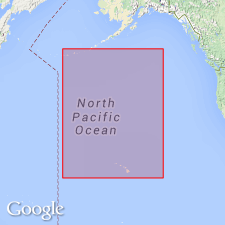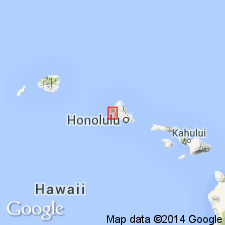
- Usage in publication:
-
- Palehua Member*
- Modifications:
-
- Geochronologic dating
- AAPG geologic province:
-
- Oahu
Summary:
K-Ar ages from Palehua member of Waianae Volcanics range from 3.2 to 2.5 Ma.
Source: GNU records (USGS DDS-6; Menlo GNULEX).

- Usage in publication:
-
- Palehua Member*
- Modifications:
-
- Named
- Geochronologic dating
- Paleomagnetics
- Dominant lithology:
-
- Basalt
- AAPG geologic province:
-
- Oahu
Summary:
Named for extensive exposures around settlement of Palehua at South end of Waianae Range, Island of Oahu. Formerly upper member of Waianae Volcanic Series (Stearns, IN Stearns and Vaksvik, 1935) excluding lavas here considered to be part of Kolekole Volcanics. Is youngest member of Waianae Volcanics. Type section is near Palehua [21 deg 23' 58"N, 158 deg 06' 11"W, Schofield Barracks 7.5' quad]; reference section is near Mount Kaala. Is hawaiite with minor alkalic and basalt and mugearite. Is 200 m thick at type. Generally conformably overlies Kamaileunu Member (new) of Waianae Volcanics. Locally as Pohakea Pass, unconformably overlies the Kamaileunu. Unconformably underlies Kolekole Volcanics and Quaternary sedimentary deposits. Hawaiite, having reversed magnetic polarity led to discovery of Kaena Reversed Polarity Subchron within Gauss Normal Polarity Chron dated at 2.85 +/-0.05 Ma (Doell and Dalrymple, 1973)
Source: GNU records (USGS DDS-6; Menlo GNULEX).
For more information, please contact Nancy Stamm, Geologic Names Committee Secretary.
Asterisk (*) indicates published by U.S. Geological Survey authors.
"No current usage" (†) implies that a name has been abandoned or has fallen into disuse. Former usage and, if known, replacement name given in parentheses ( ).
Slash (/) indicates name conflicts with nomenclatural guidelines (CSN, 1933; ACSN, 1961, 1970; NACSN, 1983, 2005, 2021). May be explained within brackets ([ ]).

